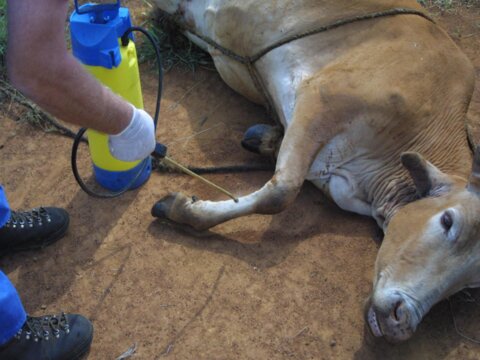Do I need to treat the whole animal with insecticide?

Treat the whole body…
The traditional method of treating cattle with insecticide to control tsetse usually follows the standard practices used for controlling ticks: the whole body is treated by either dipping or spraying the animal to run-off with a dip wash, or a pour on formulation is applied along the animal’s back line.
...or just where tsetse land?
Studies of various species of tsetse in Zimbabwe, Tanzania, South Africa and Burkina Faso have shown that most tsetse land and feed on the legs and/or belly of cattle. So with the standard method of treating cattle most of the insecticide is applied to the places where tsetse don’t land!
However, by treating just the legs and belly of cattle, we can reduce the amount of insecticide used by 80% and still get good control. This ‘restricted application’ of insecticide not only saves money and the need for expensive plunge dips or spray races and spraying equipment, but is also safer for the environment.
So what’s best?
It depends what you are trying to control. If your main concern is ticks then follow the standard procedure, as instructed on the label. If your main concern is tsetse, then the restricted application method will be cheaper. To see examples of the standard and restricted application procedures for a 1% formulation of deltamethrin pour–on look here.
But I want to control ticks and tsetse!
Farmers in Uganda were concerned about ticks and tsetse, so they sprayed the legs, belly and ears of their cattle with deltamethrin which provided good control of tsetse and various species of tick including the brown ear tick (Rhipicephalus).
In Burkina Faso, farmers found that using a footbath to treat the legs of their cattle with deltamethrin provided good control of tsetse and bont ticks (Amblyomma).
References
Bouyer, J., F. Stachurski, I. Kaboré, B. Bauer and R. Lancelot. (2006) Tsetse control in cattle from pyrethroid footbaths. Prev Vet Med. 2007 Mar 17;78(3-4):223-38. Epub 2006 Nov 28.
Stachurski, F., J. Bouyer and F. Bouyer. (2006) La lutte contre les ectoparasites des bovins par pédiluve : une méthode innovante utilisée en zone péri-urbaine sub-humide du Burkina Faso. Revue d’Elevage et de Médicine Vétérinaire des Pays Tropicaux 58, 221-228.
Torr, S.J., Maudlin, I. & Vale, G.A. (2007) Less is more: the restricted application of insecticide to cattle to improve the cost and efficacy of tsetse control. Medical & Veterinary Entomology Volume21, Issue1 53-64